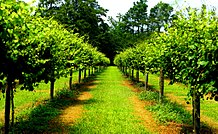
Scuppernong

| Scuppernong | |
|---|---|
| Grape (Vitis) | |
 Green Scuppernongs among Muscadine mix | |
| Color of berry skin | Blanc |
| Species | MUSCADINIA ROTUNDIFOLIA MICHAUX VAR. ROTUNDIFOLIA |
| Also called | "Big White Grape" |
| Origin | United States |
| Formation of seeds | Complete |
| Sex of flowers | Female |
| VIVC number | 10847 |
The scuppernong is a large variety of muscadine (Vitis rotundifolia),[1] a species of grape native to the southern United States. It is usually a greenish or bronze color and is similar in appearance and texture to a white grape, but rounder and larger.

First known as the "big white grape",[2] the grape is commonly known as the "scuplin" in some areas of the Deep South and also as the "scufalum", "scupanon", "scupadine", "scuppernine", "scupnun", or "scufadine" in other parts of the South. The scuppernong is the state fruit of North Carolina.[3][4]

History

The name comes from the Scuppernong River in North Carolina mainly along the coastal plain. It was first mentioned as a "white grape" in a written logbook by the Florentine explorer Giovanni de Verrazzano while exploring the Cape Fear River Valley in 1524.[3] He wrote of "...[m]any vines growing naturally there...". Sir Walter Raleigh's explorers, the captains Philip Amadas and Arthur Barlowe, wrote in 1584 that North Carolina's coast was "...so full of grapes as the very beating and surge of the sea overflowed them...in all the world, the like abundance is not to be found."[5]

He may have been referring to Sargasso seaweed from coral reefs, which can be seen washed up on shore after a major storm off the North Carolina coast. The seaweed has berrylike gas-filled bladders looking much like grapes to keep the fronds afloat.

However, in 1585, Governor Ralph Lane, when describing North Carolina to Raleigh, stated: "We have discovered the main to be the goodliest soil under the cope of heaven, so abounding with sweet trees that bring rich and pleasant, grapes of such greatness, yet wild, as France, Spain, nor Italy hath no greater...".

The Scuppernong grape was first cultivated during the 17th century, particularly in Tyrell County, North Carolina. Isaac Alexander found it while hunting along the banks of a stream feeding into Scuppernong Lake in 1755; it is mentioned in the North Carolina official state toast.[6] The name itself traces back to the Algonquian word ascopo, meaning "sweet bay tree".

Cultivation

The fruit grows where temperatures seldom fall below 10 °F (−12 °C).[7] Injury or freeze can occur where winter temperatures drop below 0 °F (−18 °C). Some cultivars, such as "Magnolia", "Carlos", and "Sterling" will survive north to Virginia and west to the Blue Ridge Mountains foothills. Nonetheless, Muscadines have a high tolerance to diseases and pests; more than 100 years of breeding has resulted in several bronze cultivars, such as "Doreen" and "Triumph", in addition to the aforementioned "Carlos" and "Magnolia’". All are distinguishable from the Scuppernong variety by being perfect-flowered (male and female flower parts together). The Scuppernong possesses only female flowering parts.

The "Mother Vine"

Possibly[8] the oldest cultivated grapevine in the world is the 400-year-old scuppernong "Mother Vine" growing on Roanoke Island, North Carolina.[9]

Use of scuppernong in the arts
In music
Scuppernong is a piece for piano in three movements by John Wesley Work III.[10]

Broomstraw Philosophers and Scuppernong Wine is a song written by country artist, Larry Jon Wilson.

In literature
Scuppernongs are mentioned in chapters 4, 5, and 22 of To Kill a Mockingbird.

Scuppernongs are also mentioned in Charles W. Chesnutt's 1899 collection of short stories The Conjure Woman.

They are also mentioned by the name "scupadine" in chapter 6 of Salvage the Bones.

"In the Scuppernongs" is the title of a chapter in Go Tell the Bees That I Am Gone, the ninth book in the Outlander series by Diana Gabaldon.

In the movie The Bad Seed, Rhoda Penmark talks about the "Scuppernong arbor" in the family's yard. In William Faulkner's novel Absalom, Absalom!, Thomas Sutpen, and Wash Jones drink whiskey and laugh together in the Scuppernong arbor on Sutpen's estate.

Scuppernongs are mentioned in Chapter 25 of MacKinlay Kantor's Civil War novel Andersonville.

References
- ^ "USDA Plants Profile Muscadine". Plants.usda.gov. Retrieved August 9, 2012.
- ^ "North Carolina State University Muscadine Grapes". Ces.ncsu.edu. June 30, 1914. Retrieved August 9, 2012.
- ^ a b Hines, Nickolaus (September 11, 2015). "Muscadine: The Grape of the South". Grape Collective. Archived from the original on April 27, 2021.
- ^ "Official State Symbols of North Carolina". ncpedia.org. Retrieved September 26, 2012.
- ^ "North Carolina Wine & Grape Council and NCDOC". Scuppernongs.com. 2005. Archived from the original on February 22, 2015. Retrieved August 9, 2012.
- ^ "GS_149-2 "A Toast" to North Carolina 2005". Ncleg.net. Retrieved August 9, 2012.
- ^ Poling, Barclay & Fisk, Connie (June 2006). "Muscadine Grapes in the Home Garden". NC State University Horticulture Information Leaflets. Retrieved September 25, 2008.
- ^ "North Carolina History Project : Mother Vine". Northcarolinahistory.org. Retrieved August 9, 2012.
- ^ Kozak, Catherine (July 14, 2008). "Mother of all vines gives birth to new wine". The Virginian-Pilot. Retrieved January 25, 2024.
- ^ Wesley, John. "Scuppernong (Work III, John Wesley) - IMSLP". IMSLP Petrucci Music Library. Retrieved January 25, 2024.
Further reading
"Scuppernong: North Carolina's Grape and Its Wines", Clarence Gohdes (Duke University Press, 1982) ISBN 0822304600

External links
![]() The dictionary definition of scuppernong at Wiktionary
The dictionary definition of scuppernong at Wiktionary

See what we do next...
OR
By submitting your email or phone number, you're giving mschf permission to send you email and/or recurring marketing texts. Data rates may apply. Text stop to cancel, help for help.
Success: You're subscribed now !
